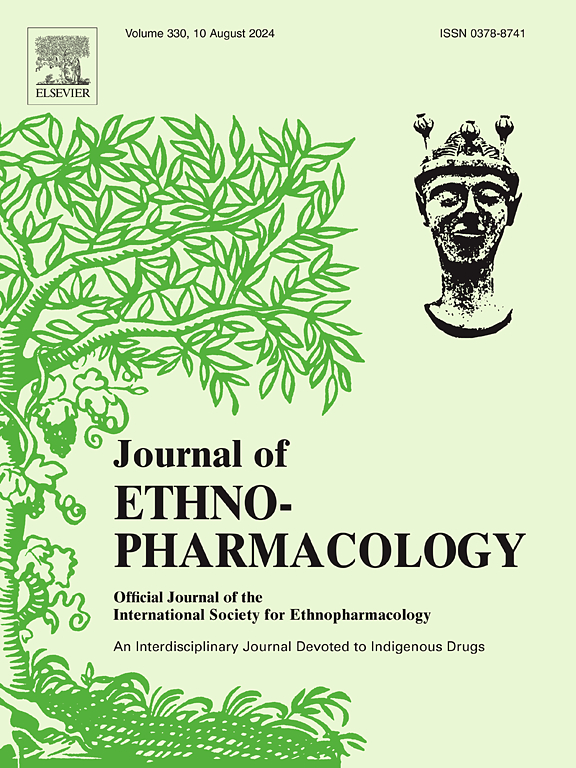The protective effect of Schisandra lignans on the hepatotoxicity induced by the metabolic activation of dictamnine
IF 5.4
2区 医学
Q1 CHEMISTRY, MEDICINAL
引用次数: 0
Abstract
Ethnopharmacological relevance
Dictamnine (DIC) is the predominant pharmacological and hepatotoxic component of Cortex Dictamni (CD). CYP3A-mediated metabolic activation plays an important role in DIC-induced hepatotoxicity. Schisandra lignans (SCLs) are the major hepatoprotective ingredients of Schisandra chinensis (SC). CD and SC are frequently used as herb pairs in traditional Chinese medical formulas particularly for the treatment of eczema and urticarial. Our preliminary studies have shown that SC can protect against CD-induced liver injury. However, the underlying protective mechanism of SC against CD-induced liver injury has remained unknown.
Aim of the study: This study aims to investigate the effects of SCLs on the hepatotoxicity and metabolic activation of DIC and elucidate the underlying hepatoprotective mechanism from the perspective of the inhibition of CYP3A-mediated metabolic activation.
Material and methods
The protective effect of SCLs against DIC-induced hepatotoxicity was evaluated by biochemical analysis and liver histological observation. The effect of SCLs on the in vitro metabolic activation of DIC was assessed by detecting the level of DIC-N-acetylcysteine (NAC) conjugates in mouse liver microsomal incubations. The effect of SCLs on the metabolic activation in vivo of DIC was examined by monitoring the toxicokinetic behaviors of DIC, DIC-induced hepatic GSH depletion, the cumulative urine excretion of DIC, the levels of DIC-NAC conjugates in urine and liver of mice, and the formation of DIC-derived cysteine-protein adducts.
Results
Our findings indicated that SCLs protected against DIC-induced hepatotoxicity in a dose-dependent manner. SCLs exhibited dose-dependent inhibitory effect on the formation of DIC-NAC conjugates in liver microsomal incubations, indicating SCLs inhibited the metabolic activation of DIC in vitro. SCLs increased Cmax and AUCs of DIC in the blood and liver of mice, leading to the enhancive accumulation of DIC in the circulation. Pretreatment with SCLs relieved hepatic GSH depletion induced by DIC, promoted the urinary excretion of DIC, inhibited the formation of reactive metabolite of DIC in urine and liver of mice, and reduced the production of DIC-derived cysteine-protein adducts, suggesting that SCLs influenced absorption, distribution, metabolism, and excretion (ADME) of DIC by suppressing the metabolic activation of DIC in vivo.
Conclusions
The study demonstrated the protective effect of SCLs against hepatotoxicity induced by DIC was related to the inhibition of CYP3A-mediated metabolic activation of DIC. Therefore, the study demonstrated that SCLs may serve as the candidate drugs for the intoxication of DIC. Moreover, our findings may interpret the protective mechanism of SC against CD-induced liver injury.

五味子木脂素对双胺胺代谢激活所致肝毒性的保护作用。
民族药理学相关性:双丹宁(DIC)是双丹皮质(CD)的主要药理和肝毒性成分。cyp3a介导的代谢激活在dic诱导的肝毒性中起重要作用。五味子木脂素(Schisandra lignans, SCLs)是五味子(Schisandra chinensis, SC)中主要的保肝成分。CD和SC在传统中药配方中经常作为草药对使用,特别是用于治疗湿疹和荨麻疹。我们的初步研究表明,SC对cd诱导的肝损伤具有保护作用。然而,SC对cd诱导的肝损伤的潜在保护机制尚不清楚。研究目的:本研究旨在从抑制cyp3a介导的代谢激活的角度,探讨scl对DIC肝毒性和代谢激活的影响,阐明其潜在的保肝机制。材料与方法:采用生化分析和肝脏组织学观察评价scl对dic肝毒性的保护作用。通过检测小鼠肝微粒体培养中DIC- n -乙酰半胱氨酸(NAC)偶联物的水平,评估scl对DIC体外代谢激活的影响。通过监测DIC的毒性动力学行为、DIC诱导的肝脏GSH消耗、DIC的累积尿排泄、小鼠尿液和肝脏中DIC- nac偶联物的水平以及DIC衍生的半胱氨酸蛋白加合物的形成,研究了scl对DIC体内代谢激活的影响。结果:我们的研究结果表明,scl对dic诱导的肝毒性具有剂量依赖性。在肝微粒体培养中,scl对DIC- nac偶联物的形成表现出剂量依赖性的抑制作用,表明scl在体外抑制DIC的代谢激活。scl增加了小鼠血液和肝脏中DIC的Cmax和auc,导致DIC在循环中的积累增强。scl预处理可缓解DIC引起的肝脏GSH耗损,促进DIC尿排泄,抑制小鼠尿液和肝脏中DIC反应性代谢物的形成,减少DIC衍生半胱氨酸蛋白加合物的产生,提示scl通过抑制DIC体内代谢激活来影响DIC的吸收、分布、代谢和排泄(ADME)。结论:本研究表明,scl对DIC肝毒性的保护作用与抑制cyp3a介导的DIC代谢激活有关。因此,本研究表明scl可能作为DIC中毒的候选药物。此外,我们的发现可能解释了SC对cd诱导的肝损伤的保护机制。
本文章由计算机程序翻译,如有差异,请以英文原文为准。
求助全文
约1分钟内获得全文
求助全文
来源期刊

Journal of ethnopharmacology
医学-全科医学与补充医学
CiteScore
10.30
自引率
5.60%
发文量
967
审稿时长
77 days
期刊介绍:
The Journal of Ethnopharmacology is dedicated to the exchange of information and understandings about people''s use of plants, fungi, animals, microorganisms and minerals and their biological and pharmacological effects based on the principles established through international conventions. Early people confronted with illness and disease, discovered a wealth of useful therapeutic agents in the plant and animal kingdoms. The empirical knowledge of these medicinal substances and their toxic potential was passed on by oral tradition and sometimes recorded in herbals and other texts on materia medica. Many valuable drugs of today (e.g., atropine, ephedrine, tubocurarine, digoxin, reserpine) came into use through the study of indigenous remedies. Chemists continue to use plant-derived drugs (e.g., morphine, taxol, physostigmine, quinidine, emetine) as prototypes in their attempts to develop more effective and less toxic medicinals.
 求助内容:
求助内容: 应助结果提醒方式:
应助结果提醒方式:


